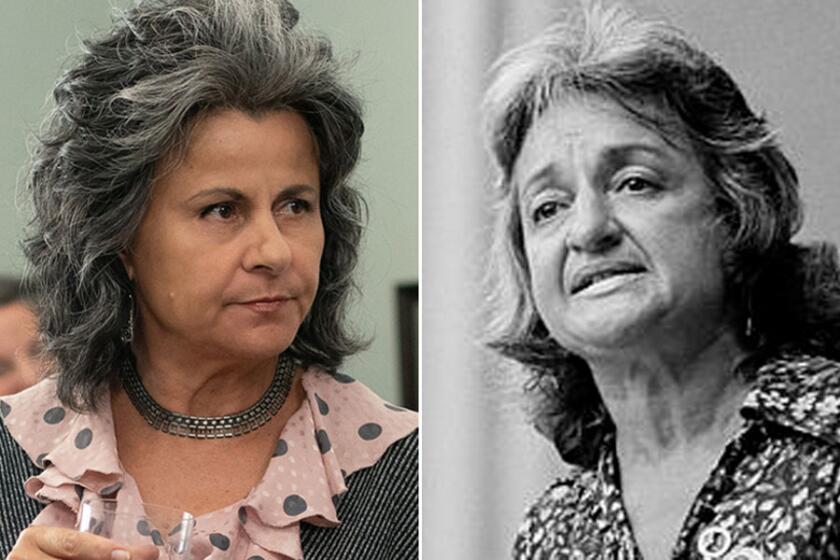How accurate is ‘Mrs. America’s’ portrayal of Phyllis Schlafly’s gay son? We researched
If you’ve watched any of “Mrs. America,” the star-studded miniseries about the battle over the Equal Rights Amendment, you may be wondering how accurately it captures this divisive chapter in American political history.
The nine-part drama pits conservative activist Phyllis Schlafly (Cate Blanchett) and her followers against a band of feminist all-stars led by Gloria Steinem (Rose Byrne), Bella Abzug (Margo Martindale), Shirley Chisholm (Uzo Aduba) and Betty Friedan (Tracey Ullman), who are prone to spirited internal debates. Creator Dahvi Waller and her team of writers conducted extensive research into Second Wave feminism and the rise of the new right in the 1970s.
Like nearly all works of historical fiction, “Mrs. America” takes some liberties, particularly when it comes to private conversations behind closed doors, and offers a necessarily subjective take on highly polarizing figures such as Schlafly, whose family and supporters have been critical of the series. But when it comes to events in the public record, “Mrs. America” hews closely to the facts, often quoting feminist leaders and their critics verbatim.
“Overall, they have done a very good job,” said historian Marjorie Spruill, author of “Divided We Stand: The Battle Over Women’s Rights and Family Values That Polarized American Politics.”
Episode 5 explores sexual identity and equality in romantic partnerships through two very different couples on opposite sides of the ERA battle. As her media profile continues to rise, Schlafly begins to worry about her son, John (Ben Rosenfield), and decides to apply to law school, leading to tension with her husband, Fred (John Slattery). Meanwhile, feminist super couple Brenda and Marc Feigen Fasteau struggle to reconcile the political and the personal.
Here’s a look at fact versus fiction in “Phyllis & Fred & Brenda & Marc” (a title clearly inspired by the classic 1969 film “Bob & Carol & Ted & Alice”).
We sort through what’s fact and what’s fiction in “Mrs. America” Episode 4, “Betty.”
Brenda Feigen was a prominent ERA proponent who debated Schlafly many times on TV, and her husband was also a vocal ally of the women’s movement
This episode contrasts the traditional Schlafly marriage with the more progressive union between Brenda Feigen and Marc Fasteau, prominent ERA proponents who met at Harvard Law School, married using the combined last name of Feigen Fasteau — a radical move at the time — and started a law firm together. In one of their high-profile cases, they filed a lawsuit against the Harvard Club for sex discrimination.
Feigen was a leading feminist in the 1970s who co-founded not only Ms. magazine and the National Women’s Political Caucus but also the ACLU’s Women’s Rights Project with Ruth Bader Ginsberg (who is briefly depicted in this episode). Fasteau was also associated with the women’s movement. In 1974, he published a book called “The Male Machine,” which explored the damaging gender expectations faced by men. In the foreword, written by Gloria Steinem, she called him a “spy in the ranks of the white male elite.” In the episode, Abzug calls Marc a “magnificent hunk of a man.” As journalists, we, of course, remain neutral with respect to his appearance but will allow readers to decide for themselves.
The couple was profiled by People magazine in 1974, shortly after the birth of their daughter, and written about as a kind of curiosity because “the women’s movement is not exactly a hotbed of happy marriages.”
Feigen has continued to be a trailblazer: She ran for New York state senate in 1978 and sued the board of elections to include her full last name on the ballot. (She lost narrowly.) Later, she made the leap into entertainment, working as an agent whose clients included Loretta Swit and producing the 1990 action film “Navy SEALS,” starring Charlie Sheen (she was profiled by The Times that year). In 2000, she published a memoir, “Not One of the Boys: Living Life as a Feminist,” detailing her activism, her marriage and, as the episode depicts, her relationships with women; she continues to practice law. She and Fasteau divorced in 1987.Feigen was one of the few feminists willing to debate Schlafly and did so several times throughout the ‘70s
As portrayed in “Phyllis & Fred & Brenda & Marc,” many prominent feminists were wary of debating Schlafly because it would only boost her profile. After declining a request to appear with Schlafly on “Meet the Press” in 1977, Steinem told an interviewer that she had a “moral obligation not to enlarge the audience for a speaker who refuses to tell the truth.” In “Outrageous Acts and Everyday Rebellion,” Steinem called Schlafly “an artificial creation of the fairness doctrine” who was propelled to national fame specifically because the news media simplistically believed that giving both sides equal time meant they were being impartial.
The couple’s debate on “Tomorrow With Tom Snyder” — which, in a meta twist, features a cameo by Rose Byrne’s partner, Bobby Cannavale, as the talk show host — appears to have been a real thing. Evidence of its existence is scant online, but in a mocking tone Schlafly discussed and shared clips from the “Tomorrow” appearance during a 2007 address in Florida.
“Tom Snyder of ‘The Tomorrow Show’ made a big effort to stage a TV debate with two couples facing off against each other. He had a terribly hard time finding any ERA advocate who had a husband,” she said, to uproarious laughter, “but he finally found one that we had never heard of, Brenda Feigen Fasteau.” It’s unclear whether Schlafly cited a non-existent case in this particular debate, as “Mrs. America” depicts, but she is wearing a large crucifix and long orange dress, so attention has clearly been paid to the details.
You can view Schlafly’s entire address here; the segment in question begins around 13:30.
Schlafly did attend law school to boost her credentials ...
Though she had a master’s degree from Radcliffe, Schlafly was often criticized because she was not a lawyer. As Spruill writes in “Divided We Stand,” “exhausted ERA proponents dismissed Schlafly as ‘just a housewife from Illinois.’” Indiana Sen. Birch Bayh said that debating someone “with no legal training” inspired him to “commit mayhem.” She enrolled in 1975, at the height of the ERA battle, and graduated in 1978. While “Mrs. America” suggests this decision created tension in the Schlafly marriage, Spruill believes that Fred in general supported his wife’s endeavors and they were, in fact, “two peas in a pod.” But that newspaper headline referring to Fred as “Phyllis Schlafly’s lawyer husband”? That was real. ... And her son John is gay
In this episode, Phyllis gradually realizes that her eldest son, John, is gay and confronts him about his sexuality in an indirect but unmistakable way, telling him how she was able to quit smoking because “the mind is stronger than the body. You just have to exercise willpower.”
While the particulars of the conversation — and the circumstances that inspired it — have almost certainly been imagined by the writers, it is true that John Schlafly is gay. He was outed by Queer World, a New York gay magazine, just after the Republican National Convention in 1992 — where cultural conservatives like Pat Buchanan and Pat Robertson trumpeted the importance of “family values” and denounced Bill Clinon’s support for gay rights.
At the time, John Schlafly said that “the family values movement is not anti-gay.”
In a 1993 interview, Schlafly said she’d known for a long time that her child was gay, but they did not discuss it until the Queer World article came out. “The only reason people bring it up is to embarrass me,” she said of the media “feeding frenzy” that transpired.
John Schlafly continued to work for his mother for years as she championed conservative values — including staunch opposition to LGBTQ rights. He was at her side at the 2004 Republican National Convention, where she pushed for language in the party platform endorsing a constitutional ban on same-sex marriage.
“It’s no problem,” she said of her activism at the time. “He supports me in everything I do.”

Opening credits of the 1974 TV special
‘Free to Be ... You and Me’
In the final scene of the episode, Marc, Brenda, Gloria and her boyfriend Frank (Jay Ellis) gather to watch “Marlo Thomas and Friends in Free to Be... You and Me” on television. The variety special, which followed an album and a children’s book, aired on ABC on March 11, 1974. It was produced by Thomas — a co-founder of the Ms. Foundation — and included appearances by Alan Alda, Mel Brooks, Harry Belafonte and Michael Jackson. “Free to Be... You and Me” won an Emmy for children’s special and became a filmstrip staple at elementary schools in the ‘70s and ‘80s.
More to Read
The complete guide to home viewing
Get Screen Gab for everything about the TV shows and streaming movies everyone’s talking about.
You may occasionally receive promotional content from the Los Angeles Times.







